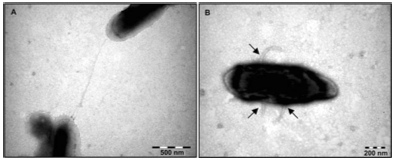Rickettsia felis: Difference between revisions
| Line 25: | Line 25: | ||
==Genome structure== | ==Genome structure== | ||
The genome of R. felis consists of a 1,485,148 bp circular chromosome and two circular plasmids, pRF (62,829 bp) and pRδ (39,263 bp). This results in 1,512 open reading frames that encode proteins2. This genome is much larger than any other Rickettsial organism with the next largest genome being the 1,111,523 bp genome of R. prowazekii2. The two plasmids have identical nucleotide sequences except for a 23,566 bp segment present only in pRF2. | |||
R. felis has multiple genes encoding toxin-antitoxin systems that are rare in obligate intracellular bacteria. These systems may help ensure propagation of bacteria in a eukaryotic host2. R. felis also has genes whose analogs in other bacteria encode conjugative pili proteins, suggesting that some of the R. felis genome may have been acquired by lateral transmission5. It appears that R. felis is the first obligate intracellular parasite to have a conjugative plasmid2. It also has genes homologous to genes encoding streptomycin and penicillin resistance2. | |||
==Cell structure and metabolism== | ==Cell structure and metabolism== | ||
Revision as of 06:20, 31 May 2007
A Microbial Biorealm page on the genus Rickettsia felis
Classification
Higher order taxa
cellular organisms; Bacteria; Proteobacteria; Alphaproteobacteria; Rickettsiales; Rickettsiaceae; Rickettsieae; Rickettsia; spotted fever group1
Species
Rickettsia felis
|
NCBI: Taxonomy |
Description and significance
“Rickettsia felis” is an obligate intracellular parasite that was first isolated from cat fleas. It is a gram-negative bacteria that was that differs from Rickettsia typhi by only 32 nucleotide differences3. It was identified in patients clinically diagnosed with murine typhus4. It was originally thought to be a member of the typhus group of rickettsiae, but upon sequencing was found to be closer to the spotted fever group of rickettsiae5.
Genome structure
The genome of R. felis consists of a 1,485,148 bp circular chromosome and two circular plasmids, pRF (62,829 bp) and pRδ (39,263 bp). This results in 1,512 open reading frames that encode proteins2. This genome is much larger than any other Rickettsial organism with the next largest genome being the 1,111,523 bp genome of R. prowazekii2. The two plasmids have identical nucleotide sequences except for a 23,566 bp segment present only in pRF2.
R. felis has multiple genes encoding toxin-antitoxin systems that are rare in obligate intracellular bacteria. These systems may help ensure propagation of bacteria in a eukaryotic host2. R. felis also has genes whose analogs in other bacteria encode conjugative pili proteins, suggesting that some of the R. felis genome may have been acquired by lateral transmission5. It appears that R. felis is the first obligate intracellular parasite to have a conjugative plasmid2. It also has genes homologous to genes encoding streptomycin and penicillin resistance2.
Cell structure and metabolism
Describe any interesting features and/or cell structures; how it gains energy; what important molecules it produces.
Ecology
Describe any interactions with other organisms (included eukaryotes), contributions to the environment, effect on environment, etc.
Pathology
How does this organism cause disease? Human, animal, plant hosts? Virulence factors, as well as patient symptoms.
Application to Biotechnology
Does this organism produce any useful compounds or enzymes? What are they and how are they used?
Current Research
Enter summaries of the most recent research here--at least three required
References
Edited by student of Rachel Larsen and Kit Pogliano

